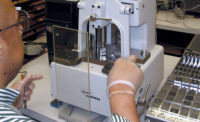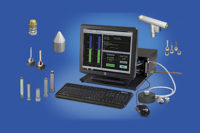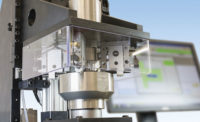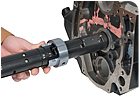
Measuring surface finish on crank bores had been relegated to the lab. Using general-purpose surface finish measuring machines, the measurements took hours to set up, and the long lag time between manufacturing and test results meant only sampling was capable. Worse, because of the length of the crank, the middle bores could not be measured at all. However, by custom designing a fixed plug surface finish system, every bearing surface can now be tested on each part right at the machine. Source: Mahr Federal Inc.
These days many people assume only rich men have their suits custom tailored. But as any tailor knows, this is far from the truth. There are many reasons, other than economic, why men-rich or otherwise-have suits tailor-made to fit their specific frames.
The same is true for dimensional gaging. There are many applications-aside from those where custom gaging is the only possible solution-where custom tailoring a gage for an application can speed things up, improve accuracy, incorporate multiple measurements, generate sophisticated analysis or otherwise add value to the process.
How does one know if an application is a candidate? That will probably take some time and money to figure out. But to keep that process as efficient as possible, here are a few things to consider before calling a gage supplier.
First, understand that a custom gage is really a production tool. It does not shape or remove metal, but it can add significant value to the production process in terms of increased throughput, reduced reject rates and overall improvement in quality. Thus, the development and acquisition of a custom gage can be evaluated like a production tool, in terms of its return on investment.
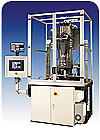
This fully automatic gage does 100% inspection of 21 characteristics on thousands of cylinder liners, in 12 seconds each. Results are recorded, classified and marked, and information about the process is fed back to the machine tool for offset compensation. No set of manual gages nor any number of inspectors were capable of the throughput this operation required. Source: Mahr Federal Inc.
Manufacturing Scenarios
And like a production tool, the need for custom gaging has its roots in some basic changes or production issues on the shop floor. Look at the following quiz and see if any of these are familiar:1.Tolerances have been tightened so that you can produce a better performing, or more competitive, product. As a result, your machines are being pushed to near their ultimate capabilities. It becomes too risky to continue sampling inspection because too many parts with uncertain measurements are getting through.
Do you:
- A. Hire more inspectors?
B. Buy better machines?
C. Buy custom gaging?
Do you:
- A. Hire more inspectors to check the inspectors you already have?
B. Institute a program to make the current inspectors more efficient?
C. Buy custom gaging?
Do you:
- A. Hire additional inspectors to work upstream?
B. Slow down the production so the operator can inspect?
C. Buy custom gaging?
Do you:
- A. Intensify the training?
B. Import experienced inspectors from other regions?
C. Buy custom gaging?
Do you:
- A. Hire fewer skilled inspectors than necessary?
B. Intensify efforts with present inspectors to perform more efficiently?
C. Buy custom gaging?
Do you:
- A. Upgrade machinery and material?
B. Invent new inspection procedures?
C. Buy custom gaging?
Justifying Costs
In an actual working environment, a custom gage can mean a lot of things to a lot of people. On the low end, a custom gage can be a $5,000 custom-designed hand gage dedicated to do one specific task. No hand tool or off-the-shelf gage could do the measurement as fast and as accurately as the custom-designed gage, and the results in time saved and performance more than justify the cost.At the other extreme, a custom gage could be a full in-line inspection system that measures numerous dimensions and geometric conditions while providing feedback to machining centers to improve the performance of the process. It would not be out of the question to spend $500,000 on such a system-but in a lights out, 24 hours a day manufacturing process, this may be the best and most cost-effective way to meet demand.

Custom air gaging is the only solution for small parts having tight tolerances. Because of the small air jet size they can be designed into small air plugs to measure multiple diameters and tapers to millionths of an inch, and within a very small area. Source: Mahr Federal Inc.
Comparing Options
If custom gaging may be the solution to a manufacturer’s needs, what information needs to be provided to the gaging company that is going to make this custom gage?One could begin by comparing hardware options, but this also could be confusing. For example, look at a “simple” outside diameter measurement on a small part. This inspection task could conceivably be performed with at least seven different gaging alternatives:
1. Surface plate method, using V-blocks and test indicator
2. Micrometer
3. Purpose-built fixture gaging
4. Snap gage
5. Bench-type inside diameter/outside diameter (ID/OD) gage with adjustable jaws
6. Handheld air ring or air fork tooling
7. A fully automated system with parts handling
Actually there are many more solutions available-such as a coordinate measuring machine-if the “not-so-simple” is included. But these options alone span a price range from about $150 to $150,000. There also are differences in many variables including gage accuracy, operator influence, throughput and data output. It is confusing, to say the least.
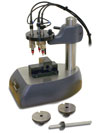
Because of tightening tolerances it became impossible to do parallelism checks with off-the-shelf gaging to meet the 0.0001-inch requirement for this application. But by combining standard components with modified components and electronic signal conditioning, the parallelism can now be checked right at the point of manufacture by the machine operators. Source: Mahr Federal Inc.
Gathering Data
A better approach is to first define the functional requirements of the inspection task, and let that steer one toward hardware that is capable of performing the tasks. In order to do this, consider the following factors:All of these factors can be important when defining the requirements for a custom gage. If one does not think of them, a good gage design company is going to ask. If they do not ask, it should be a red flag. It is critical to ask these questions up front, or one may be living with some assumptions for a long time. Define as many as possible to help narrow the field, but remember that help is readily available from most manufacturers of gaging equipment-just ask.
Finally, evaluation of the gage maker should be as thorough as the evaluation of the hardware. Field engineers experienced in providing on-the-spot assistance and full representation of the company’s needs are more than just a convenience. An ability to work with the buyer on the design of the gage is essential. Close liaison between the manufacturer’s design staff and the buyer’s team helps ensure successful completion of a gage that will meet all specifications. Q
